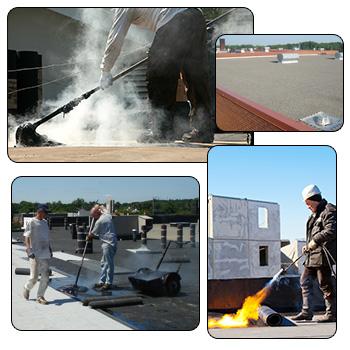
Tar & Gravel | Torch Down Roofing
Structures often times have flat roofs, but some modern and historic homes also have roofs with little or no slope. A tar and gravel roof is a type of flat roofing used for some these homes.
What is Tar & Gravel roofing?
 A tar and gravel roof is also known as built up roof or BUR. Traditionally, a tar and gravel roof is usually made of 3 to 5 laminated layers, which are made from asphalt base sheets, hot tar and roofing felt. A top layer of bitumen and extra top mineral coating is also added.
A tar and gravel roof is also known as built up roof or BUR. Traditionally, a tar and gravel roof is usually made of 3 to 5 laminated layers, which are made from asphalt base sheets, hot tar and roofing felt. A top layer of bitumen and extra top mineral coating is also added.
Light- colored gravel is used to cover the dark roofing layers. The gravel weighs down the roofing materials, protects the roofing layers against sun damage, and reflects some of the suns light. An even layer of gravel must be kept on the roof at all times. Drains and downspouts are also built in to drain any water from the roof.
Compared to other roofing products, built up roofing is quite inexpensive. However, the lifespan of a tar and gravel roof is only about 10 to 20 years, depending on its installation and the climate. Some well-maintained tar and gravel roofs may last up to 25 years.
Extreme sun can also damage the roofing membrane if it is exposed and not covered by the gravel.
An older tar and gravel roof can be fixed by patching the roofing membrane. Adding additional roofing layers made out of fiberglass can add further insulation. Also, applying a new acrylic/elastomeric cool roof coating can further weatherproof a tar and gravel roof.
Although these refurbishing measures can extend the roofs lifespan, it should only be done if the roof is still structurally sound. Otherwise, the entire roof will need to be replaced.
Installing or fixing a tar and gravel roof is very different from installing or fixing conventional roofing shingles. Its important to find a roofer who has worked extensively with tar and gravel roofing and ask for references.
What is Tar & Gravel roofing?
 A tar and gravel roof is also known as built up roof or BUR. Traditionally, a tar and gravel roof is usually made of 3 to 5 laminated layers, which are made from asphalt base sheets, hot tar and roofing felt. A top layer of bitumen and extra top mineral coating is also added.
A tar and gravel roof is also known as built up roof or BUR. Traditionally, a tar and gravel roof is usually made of 3 to 5 laminated layers, which are made from asphalt base sheets, hot tar and roofing felt. A top layer of bitumen and extra top mineral coating is also added.Light- colored gravel is used to cover the dark roofing layers. The gravel weighs down the roofing materials, protects the roofing layers against sun damage, and reflects some of the suns light. An even layer of gravel must be kept on the roof at all times. Drains and downspouts are also built in to drain any water from the roof.
Compared to other roofing products, built up roofing is quite inexpensive. However, the lifespan of a tar and gravel roof is only about 10 to 20 years, depending on its installation and the climate. Some well-maintained tar and gravel roofs may last up to 25 years.
Extreme sun can also damage the roofing membrane if it is exposed and not covered by the gravel.
An older tar and gravel roof can be fixed by patching the roofing membrane. Adding additional roofing layers made out of fiberglass can add further insulation. Also, applying a new acrylic/elastomeric cool roof coating can further weatherproof a tar and gravel roof.
Although these refurbishing measures can extend the roofs lifespan, it should only be done if the roof is still structurally sound. Otherwise, the entire roof will need to be replaced.
Installing or fixing a tar and gravel roof is very different from installing or fixing conventional roofing shingles. Its important to find a roofer who has worked extensively with tar and gravel roofing and ask for references.


